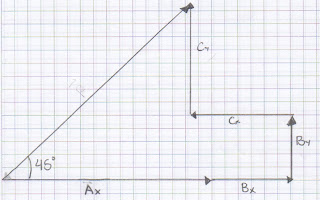Our group started with magnitudes 200cm, 100cm, and 150 cm with degrees of 0, 41, and 132 respectively. This is the graph of the vectors given. Thee scale is 1 cm = 20 g.
Vector D is the resultant force. The angle of vector D and the x-axis is 45 degrees.
This graph also shows the x and y components of each vector.
Vector A) Ax = 200g x = 200+100cos(41)+150cos(132) = 175.1g
Ay = 0g y = 0+100sin(41)+sin(132) = 177.1g
Vector B) Bx = 100cos(41) = 75.5g
By = 100sin(41) = 65.6g R = 250g at 45 degree
Vector C) Cx = 150cos(132) = -100.4g Rx = 250cos(45) = 176.8g
Cy = 150sin(132) = 111.5g Ry = 250sin(45) = 176.8g
This graph is solely the x and y components of each vector. The final vector goes from the tail of the first to the head of the last. That vector is the resultant vector.
These pictures are of the circular force table. Our measurements were correct because the first time we put the weights on at the given angles, it was balanced.
This is the picture from the simulation website. using our vectors, we got the same resultant vector.
Conclusion: In this lab we worked with vectors. We found the resultant vector from three vectors given. With this we found that it is balanced with wights and angles that were given. I learned that vectors are basically trig problems. This problem was fairly simple and we didn't have any errors with calculations. We did calculate our vectors two ways, mathematically and with a graphical approach. In our math we got whole numbers but graphically we got numbers that were decimals but could be rounded to the same numbers as ours. Another source of error comes from using the force table. There could have been friction or it could have been unbalanced (in out favor) which would have thrown off the balance. If out calculations were off and the table wasn't balanced but it said it was is why it would be in our favor.





Raychel,
ReplyDeleteNice start. Were there possibly errors in using the force table? Also which method is more accurate -- graphical method or components?
Please comment on these in your conclusions.
grade for now == s-
Let me know when you've fixed the above comments and I'll regrade.